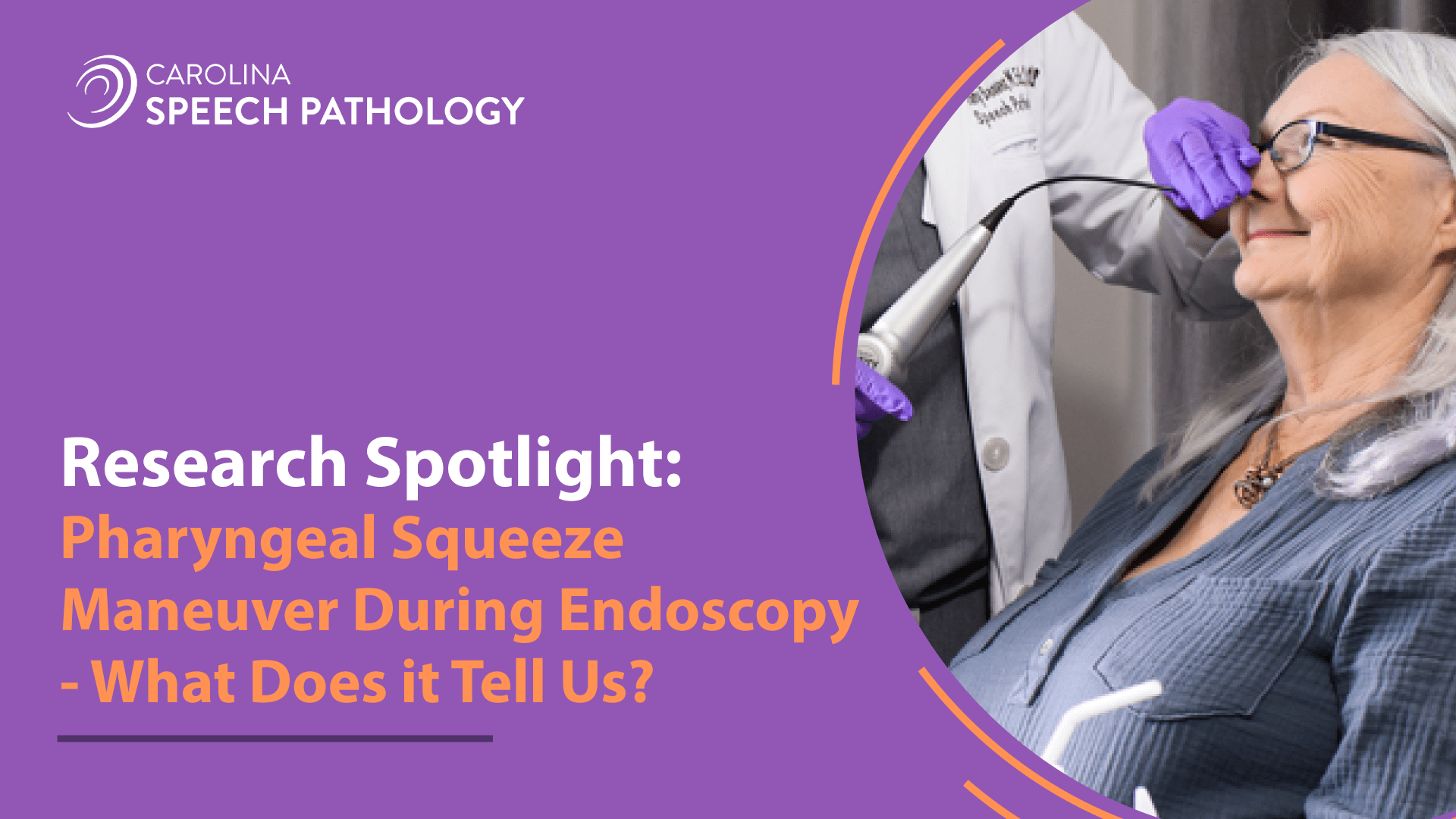In this blog, we will be reviewing the recent publication Pharyngeal Squeeze Maneuver During Endoscopy – What Does it Tell Us? by Anna Miles, Ph.D. and Alexandra Hunting, M.S. Carolina Speech Pathology is so grateful for the work of researchers such as Dr. Miles as we rely on their findings to support evidence-based practice and high quality dysphagia care.
The pharyngeal squeeze maneuver (PSM) is a non-swallowing task that has been used in Carolina Speech Pathology’s FEES protocol for many years. Using non-swallowing tasks is helpful in teasing out where physiological deficits may lie. Non-swallowing tasks are integral to isolate movements without the burden of bolus presentations. Dr. Langmore’s book Endoscopic Evaluation and Treatment of Swallowing Disorders, which many endoscopists utilize to guide their practice, includes using the Langmore FEES Protocol. The Protocol notes that using pharyngeal constriction maneuver in isolation allows for an unobstructed view of pharyngeal squeeze. It is important to note that non-swallowing tasks may yield diminished effort or less robust movements when compared to swallowing, thus this information is gathered and synthesized with other data identified during the exam. It is critical to also incorporate thorough frame-by-frame analysis to pinpoint patterns of impairment.Pharyngeal constriction is one of the most commonly reported physiological swallowing deficits. The pharyngeal constriction ratio (PCR), which is identified on the Modified Barium Swallow Study, has been demonstrated to correlate with post-swallow residue and post-swallow aspiration. Interestingly, the pharyngeal squeeze maneuver was not validated for FEES until 2009 when Fuller and colleagues examined it using simultaneous FEES/MBSS. According to Dr. Miles and Ms. Hunting, the PSM isn’t typically used in FEES protocols. This was a surprise to learn since Carolina Speech Pathology has traditionally used PSM in practice as well during FEES training since we follow a Langmore-based FEES protocol.
This paper was a prospective, observational study examining 222 consecutive inpatients who received FEES while admitted at an acute hospital. The purpose was to ask the following questions:
- Does PSM correlate with swallowing indices indicative of bolus retention difficulties (e.g., residue, accumulated secretions, and aspiration)?
- Does PSM correlate with swallowing indices indicative of motoric impairment (e.g., vocal cord paresis and reduced cough peak flow)?
- Does PSM correlate with worsening clinical outcomes (e.g., length of stay and diet on discharge)?
Design:
The patients were referred for FEES following a clinical swallow evaluation between September 2018 and November 2021. Exclusion criteria included history of dysphagia, head/neck cancer, unstable to tolerate endoscopy or complete the protocol. Patients underwent an acoustic measurement of swallow frequency, a FEES protocol including non-swallowing tasks and sensory testing, and peak flow testing utilizing three trials to determine peak expiratory flow. Blind examiners watched the FEES videos, 10% of the FEES videos were examined by a second separate blinded clinician. They reported PAS and Yale Residue scales for each trial and a max PAS score and Max Yale scores (maxYale valleculae, maxYale pyriforms) were calculated. The following data was also collected: age, gender, ethnicity, medical history, clinical presentation, pneumonia (Mann Criteria), length of stay, length of tube feeding, mortality, diet recommendations following FEES and at discharge. For participants who also received a Modified Barium Swallow Study within 72 hours of FEES, the PSM was compared to determine if the two correlate. For those who completed MBSS, the blind raters independently analyzed the PCR.
Results:
Ninety-five patients had neurological diagnosis (stroke, neurodegenerative disease), 49 were considered non-neurological (cardio-thoracic, respiratory, sepsis), 44 were neurosurgical (TBI, tumor, spinal cord injury) and 34 were “other” (ortho, oncology, frail).
The results found that pharyngeal squeeze maneuver was noted to be impaired in 46% of patients on FEES. Abnormal PSM was significantly associated with the neurology diagnosis. Also, for the patients with abnormal PSM, the New Zealand Secretion Scale, MaxPAS, MaxYale for Valleculae and MaxYale for Pyriform were significantly more impaired when compared with those whose PSM was judged to be normal. Abnormal PSM was also significantly associated with vocal fold immobility, reduced peak cough flow, and reduced swallow frequency.
PSM identified on FEES correlated with PCR identified on MBSS 100% of the time. Patients with abnormal PSM were on more restrictive diets and experienced prolonged NGT use. Eighty-eight percent of those who were NPO were found to have abnormal PSM on FEES. An abnormal PSM was also found to be associated with being discharged with more diet restrictions.
Discussion:
This paper outlines the significant relationship between PSM and secretions, pharyngeal residue, swallows per minute, cough peak flow, and neurological diagnosis. This data helps us to support continued use of measuring PSM on endoscopy, yet now we can do so with an increased level of confidence given the agreement with the well studied PCR utilized via MBSS. Further, this data helps predict our patients’ outcomes so that we can appropriately plan their course of intervention. Future research may include FEES measurements of PSM before/after intervention. Also, laryngologists may be able to use pharyngeal constriction to identify patients who may need to be referred for swallow assessment by a speech pathologist. Clearly, this simple task can easily be a part of any endoscopy protocol, and we are excited for how these results will further our field and ultimately help us best support our patients.
***
Fuller SC, Leonard R, Aminpour S, Belafsky PC. Validation of the pharyngeal squeeze maneuver. Otolaryngol Head Neck Surg. 2009;140(3): 391-394.
Langmore SE. Scoring a FEES examination. In: Langmore SE, ed. Endoscopic Evaluation and Treatment of Swallowing Disorders. New York,
NY: Thieme; 2001:101–143.
Miles A, Hunting A. Pharyngeal Squeeze Maneuver During Endoscopy-What Does it Tell Us? Laryngoscope. 2023 May 31. doi: 10.1002/lary.30796. Epub ahead of print. PMID: 37254957.

